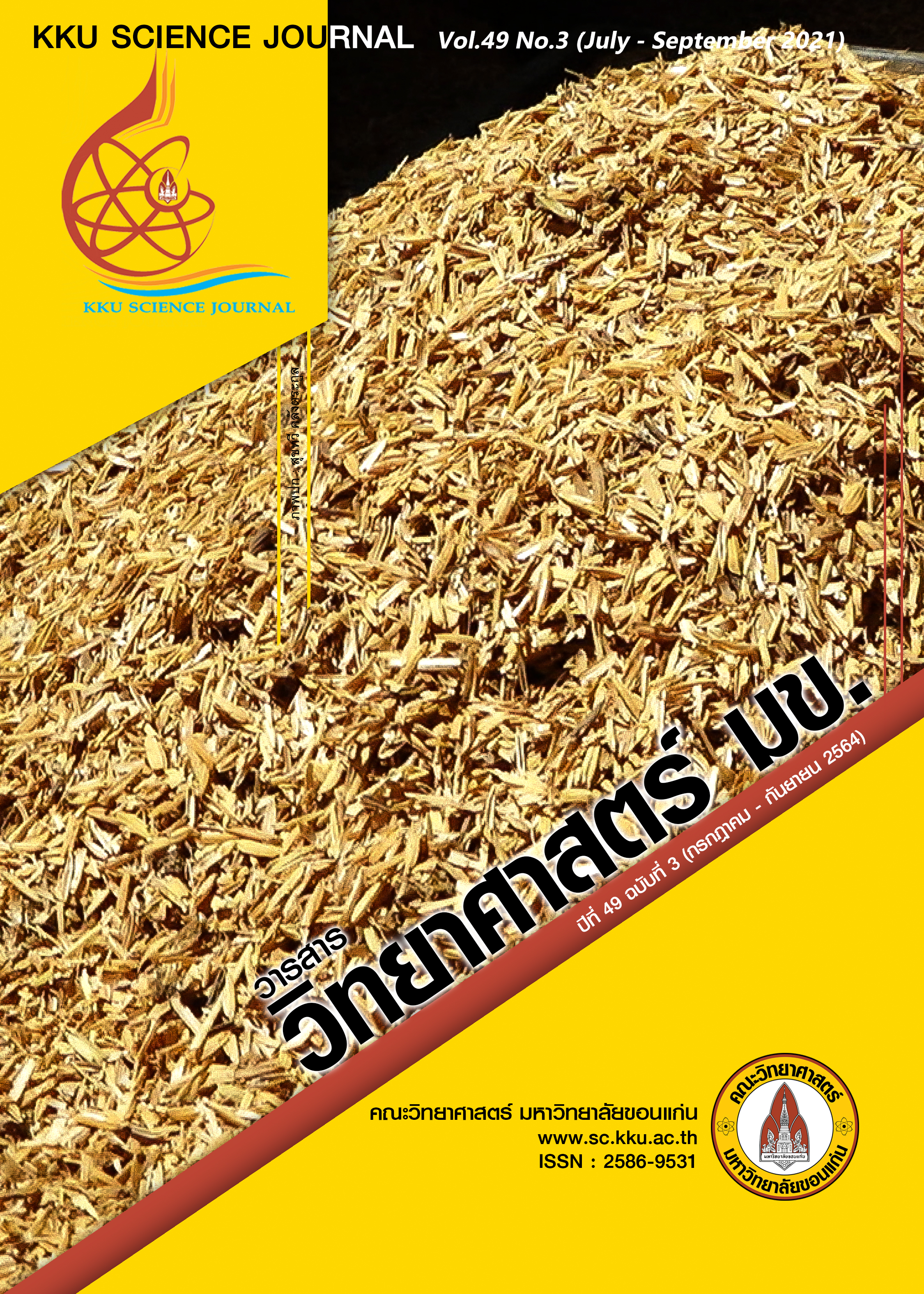การประมาณความเข้มรังสีดวงอาทิตย์ในช่วงความยาวคลื่นที่พืชใช้สังเคราะห์แสงด้วย ปัญญาประดิษฐ์จากข้อมูลภาพถ่ายท้องฟ้าและมุมเซนิธของดวงอาทิตย์
Main Article Content
บทคัดย่อ
ในงานวิจัยนี้จะประมาณความเข้มรังสีดวงอาทิตย์ในช่วงความยาวคลื่นที่พืชใช้สังเคราะห์แสงด้วยวิธีโครงข่ายประสาทเทียม (ANN) โดยใช้ข้อมูลปริมาณเมฆที่คํานวณจากภาพถ่ายสภาพท้องฟ้าด้วยวิธีการโครงข่ายประสาทแบบคอนโวลูชัน (CNN) และมุมเซนิธของดวงอาทิตย์ ข้อมูลทั้งหมดได้จากข้อมูลการวัดใน 4 ภูมิภาคหลักของประเทศไทย ได้แก่ ภาคเหนือที่ศูนย์อุตุนิยมวิทยาภาคเหนือ จังหวัดเชียงใหม่ ภาคตะวันออกเฉียงเหนือที่ศูนย์อุตุนิยมวิทยา ภาคตะวันออกเฉียงเหนือ จังหวัดอุบลราชธานี ภาคกลางที่ภาควิชาฟิสิกส์ คณะวิทยาศาสตร์ มหาวิทยาลัยศิลปากร จังหวัดนครปฐม และภาคใต้ที่ศูนย์อุตุนิยมวิทยาภาคใต้ฝั่งตะวันออก จังหวัดสงขลา จากนั้นนําข้อมูลดังกล่าวมาสร้างแบบจําลองด้วยวิธีโครงข่ายประสาทเทียม ในส่วนข้อมูลการทดสอบแบบจําลองจะใช้ข้อมูลภาคตะวันออกที่มหาวิทยาลัยบูรพา วิทยาเขตสระแก้ว ดังนั้นข้อมูลการสร้างและทดสอบแบบจําลองจึงไม่มีความเกี่ยวข้องกันแต่ประการใด ในการสร้างแบบจําลองสําหรับคํานวณปริมาณเมฆจากวิธีโครงข่ายประสาทเทียมแบบคอนโวโลชัน พบว่าแบบจําลองให้ค่าความแม่นยําในการเรียนรู้ (learning rate) สูงถึงประมาณ 87% และเมื่อนําข้อมูลปริมาณเมฆที่ได้จากแบบจําลองและมุมเซนิธของดวงอาทิตย์มาทดสอบแบบจําลองสําหรับประมาณความเข้มรังสีดวงอาทิตย์ในช่วงความยาวคลื่นที่พืชใช้สังเคราะห์แสงด้วยวิธีโครงข่ายประสาทเทียม พบว่าวิธีการคํานวณปริมาณเมฆโดยวิธีการโครงข่ายประสาทเทียมแบบคอนโวลูชันให้ผลดีที่สุดมีค่าสัมประสิทธิ์สหสัมพันธ์ (R2) เท่ากับ 0.80 ค่า RMSE เท่ากับ 19.3% และค่า MBE เท่ากับ 1.18%
Article Details

This work is licensed under a Creative Commons Attribution-NonCommercial-NoDerivatives 4.0 International License.
References
Basheer, I. A. and Hajmeer, M. (2000). Artificial neural networks: fundamentals, computing, design, and Application. Journal of Microbiological Methods 43(1): 3-31.
Caya, M. V. C., Alcantara, J. T., Carlos, J. S. and Cereno, S. S. B. (2018). Photosynthetically Active Radiation (PAR) Sensor Using an Array of Light Sensors with the Integration of Data Logging for Agricultural Application. In: International Conference on Computer and Communication Systems (ICCCS). 377-381.
Frouin, R. and Murakami, H. (2007). Estimating photosynthetically available radiation at the ocean surface from ADEOS-II global imager data. Journal of Oceanography 63(2007): 493–503.
Iqbal, M. (1983). An Introduction to Solar Radiation. New York: Academic Press. Janjai, S., Wattan, R. and Sripradit, A. (2015). Modeling the ratio of photosynthetically active radiation to broadband global solar radiation using ground and satellite-based data in the tropics. Advances in Space Research 56(11): 2356-2364.
Kim, J., Lee, J. K. and Lee, K. M. (2016). Accurate Image Super-Resolution Using Very Deep Convolutional Networks. Proceedings of the IEEE Conference on Computer Vision and Pattern Recognition. 1646-1654.
Mathworks. (2019). Convolution neural networks, Available at: https://www.mathworks.com/solutions/deep-learning/convolutionalneural-network.html.
McCree, K. J. (1966). A solarimeter for measuring photosynthetically active radiation. Agricultural Meteorology 3(5): 353-366.
Tao, X., Liang, S., Wang, D., He, T. and Huang, C. (2018). Improving Satellite Estimates of the Fraction of Absorbed Photosynthetically Active Radiation Through Data Integration: Methodology and Validation. IEEE Transactions on Geoscience and Remote Sensing 56(4): 2107-2118.
Tkemaladze, G. Sh. and Makhashvili, K. A. (2016). Climate changes and photosynthesis. Annals of Agrarian Science 14(2): 119-126.

